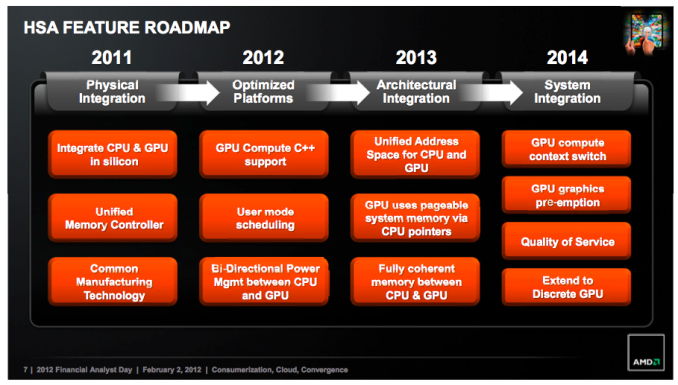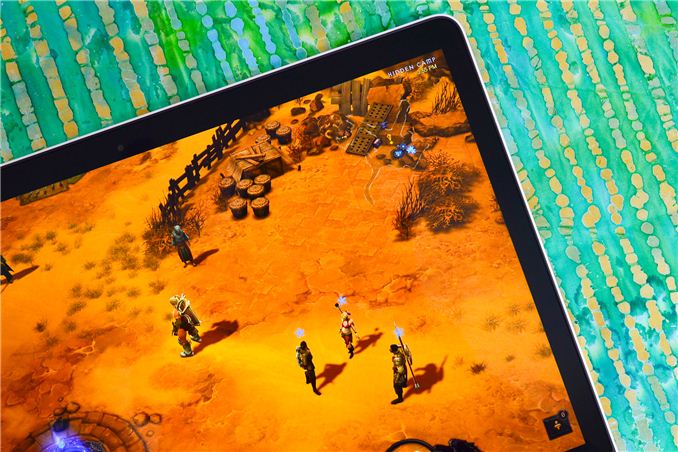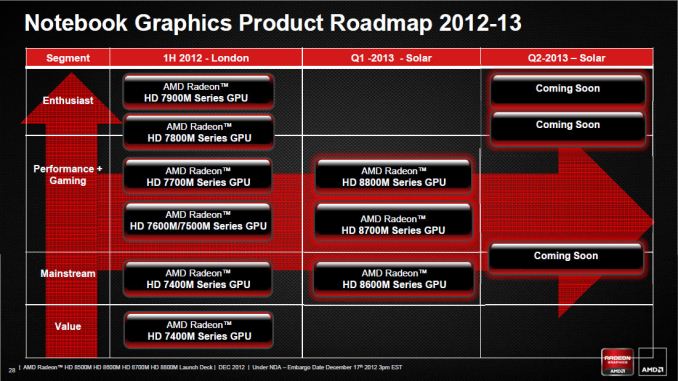I remember back when AMD’s CTO of the Graphics Product Group, Raja Koduri, first quietly left the company for Apple. This was hot on the heels of Apple’s hiring of another AMD GPU CTO, Bob Drebin. At the time (2009) I didn’t understand why Apple would want so many smart graphics guys on staff, were they working on their own GPU? Mac OS X was hardly a gaming platform of choice back then so the idea didn’t make much sense to me. It turns out that Steve Jobs wanted to surround himself with the absolute best in the business. Today, the impact of the work of folks like Bob Drebin, Raja Koduri, Jim Keller and others is quite evident. Apple tends to ship some of the fastest GPU hardware in the mobile industry, and its work in bringing high-DPI displays to virtually all of its products is unparalleled. Apple also played a huge role in driving the performance of Intel’s processor graphics. It turns out, that’s what happens when you hire a bunch of crazy smart GPU folks.
Last year AMD announced it re-hired one of the folks who eventually landed at Apple:
CPU architect Jim Keller. Keller was responsible for one of the more memorable AMD CPU architectures, as well as played an unknown role in the development of Apple’s own CPU roadmap (Keller likely had a hand in the planning for
Swift).
Today, word of another major hire surfaced earlier than expected: Raja Koduri now works at AMD once again. For the past 4 years Raja has been working on
all things graphics at Apple, but now thanks to a great offer and a fear of getting too comfortable at Apple, he's back at AMD.
Raja Koduri returns to AMD as a Corporate Vice President of Visual Computing, the implication of the title is more important than its indication of how highly AMD values its latest hire. In Raja’s previous role as graphics CTO at AMD, he oversaw GPU hardware but didn’t directly oversee AMD’s software development. For the first time in recent history, both GPU hardware and software are falling under the same man.
The timeframe for Raja’s influence depends on what you’re talking about. Raja’s immediate goal is to ensure that AMD has the best GPU architecture/hardware possible. Unfortunately, it will likely take 2 - 3 years to realize this goal - putting the serious fruits of Raja’s labor somewhere around 2015 - 2016. Interestingly enough, that’s roughly the same time horizon for the fruits of Jim Keller’s CPU work at AMD.
Raja believes there’s likely another 15 years ahead of us of good work in high-end discrete graphics, so we’ll continue to see AMD focus on that part of the market. However, Raja’s efforts will span everything from discrete GPUs to its own APU/SoC strategy. There’s no change there from the path AMD has been on for the past few years now, but it’s good to hear that as much as low power matters, high performance is still on the to-do list.
More immediately you’ll see bits and pieces of Raja’s influence emerge. Everything from hardware to drivers and developer relations now falls under Raja’s umbrella. Presumably, all should improve - with the latter two seeing impacts sooner than the 2 - 3 year timeframe it would take for us to see results in hardware. We recently spoke about
AMD’s multi-GPU frame pacing issues and I wouldn’t be surprised if that’s one of the first bits of low hanging fruit that Raja gets his teams to address quickly.
Raja returns to a very different AMD than the one he left. I asked him what’s different and he responded by saying the AMD he left acted like a company that was 10x its size. Today, AMD is a much smaller and more agile company. Raja believes AMD is in a better position to take advantage of new opportunities vs. being in the hopeless position of never being able to catch up in mature markets. It’s difficult to see what the next big mover will be after smartphones. Intel is betting on the TV industry, but to be honest no one knows. What drives Raja is the belief that delivering good quality, high performance and low power graphics will continue to matter going forward. I agree.
For years, Intel held back appreciation of good graphics performance in the PC space but the current mobile revolution has changed all of that. Graphics performance is just as important as CPU performance, a fact that Intel will itself embrace with Haswell/Broadwell.
Raja views AMD’s challenges as being difficult, but not unsurmountable. AMD needs a great graphics architecture and it needs a great SoC. Raja’s scope will include making sure that, at least on the graphics hardware/software/dev-rel side, AMD is in the best possible shape. Jim Keller will do the same for AMD’s CPUs. AMD
remains focused on this idea of servicing vertically integrated players, although it's still difficult to see how that strategy is going to play out given how today's vertically integrated players (outside of game consoles) aren't big on using AMD hardware.

I’ve known Raja for over a decade now, and he’s always struck me as a man in search of a challenge. Given the revolution that we’ve seen at Apple over the past few years, Raja’s attraction to Cupertino made sense. However, I don’t think you could ask for a bigger challenge than the position AMD is in today. Raja (and others at AMD) believe there’s still room for new hires, although they are very interested in bringing in new blood.
Update: Some have asked for clarification on Raja's LinkedIn, reflecting his position as Technical Advisor to Makuta (Raja is full time with AMD, Makuta is a side project of his). I asked Raja and he offered the following response:
"I always had the dream of building a Pixar like company in India and I got an opportunity to engage with a group of people who have the same mission. AMD allowed me to stay engaged on this endeavor and that's one of the reasons I chose AMD."
Whether or not the past several high profile hires are enough to save AMD is something we won’t know for sure until 2015/2016. One thing is certain, AMD is trying to assemble a group of folks crazy enough to try and turn this company around.














72 Comments
View All Comments
silverblue - Saturday, April 20, 2013 - link
Make that three of us in the same position...ET - Saturday, April 20, 2013 - link
Bad or even mediocre managers can screw up a company quite easily, and they're pretty common, so if a company can find a good one and hold on to him, they should.axien86 - Friday, April 19, 2013 - link
AMD builds a powerful Jaguar APU based on a 1.63mm x 1.90mm core size with design wins from Sony and Microsoft for next gen consoles. Major Taiwan ODMs are showcasing AMD Jaguar-based tablets running the latest apps and games at 1920x1080 res and 8-10 hour battery life while Intel designs struggles with games at half-HD resolutions.AMD with 1/10 the resources, delivered compelling gaming console, tablet and hybrid notebook solutions for the second half of this year. Meanwhile Intel with half empty fabs, has a buggy, bigger Haswell and promises of a better Baytrail Atom "real soon now"... (meaning samples at end of 2013 and shipping well after 2014...)
With this in mind, I think most people would congratulate AMD for what they created and for what is yet to come.
THizzle7XU - Friday, April 19, 2013 - link
I really think the fact that they have at least one chip in all three of the next gen consoles is a huge sleeper hit for them. It is really not talked about much other than a side comment. Considering each gen sells more than the previous and the current gen is sitting at around 250 million consoles since 2005, a conservative estimate (Wii U GPU + PS4 CPU + PS4 GPU + 720 CPU + 720 GPU) * 250 million = 1.25 billion AMD chips sold in the next ten years or so. That's crazy.Mr Perfect - Saturday, April 20, 2013 - link
I initially thought the same thing, it looks like AMD is ready to cash in no matter who wins the next console round. Do we know what the margins are on console hardware though? My guess is it's pretty low. If the entire console sells for about the same as one normal GPU or CPU, they can't be getting to much.phillyry - Saturday, April 20, 2013 - link
That's because the console OEMs (Sony & MS) take a hit on the first couple million units, until economies of scale kick in, betting long - that they'll make it up in ecosystem (read game) purchases.Doesn't mean AMD and other parts vendors are super discounting their hardware. They'll just batch price by volume based contracts.
DanNeely - Wednesday, April 24, 2013 - link
AMD more or less won the consoles by default though. nVidia decided the margins weren't high enough to justify pulling people off their other projects. Intel's GPUs are still no-shows for anything beyond casual gaming; and I doubt they'd be overly interested in a low margin market segment either.Dal Makhani - Friday, April 19, 2013 - link
Buggy Haswell? Its perfectly fine. Why do people exaggerate the minor chipset errata? Its not smart of you to start knocking intel like that with their great R&D which contribute to the industry, however i agree that AMD's win in mobile and consoles is great and yes under appreciated/recognized. They needed to shed the resources to become a more focused/efficient company even according to this article which Raja mentioned. It will just be a good day when AMD can again really impress with the desktop CPU, unless thats not on their radar anymore.silverblue - Saturday, April 20, 2013 - link
Core 2 had shedloads of bugs, but they still worked round it. The original Phenom had one bug blown totally out of proportion which affected very few home users (and had a workaround - 10% performance drop on Windows, 0% on Linux), so in reality, the only bad things about Phenom were the process and hence the inability to clock it high or keep power under control.CPUs always launch with bugs and they're generally caught and bypassed. However, I suppose AMD did deserve the flak for Phenom's TLB bug after saying Phenom would bury Core 2...
Dal Makhani - Sunday, April 21, 2013 - link
you are correct theres bugs, but often i dont hear of mass recalls or they affect only some, but that is expected. Haswell isnt even out yet, but im assuming the OP was saying haswell is buggy just because of the Z87 chipset USB problem. Intel has said the CPU itself has no major bugs. So i dont see the need to worry so much.